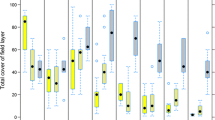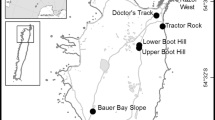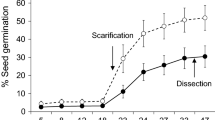Abstract
Natural tree regeneration in abandoned pastures can be hampered by various biotic and abiotic filters, including seed removal and predation. We tested the effects of maintenance and removal of grass and seed deposition (buried and unburied) on seed germination of 12 tree species in dry forest pastures. We obtained evidence supporting the hypothesis that seeds attain higher germination under a grass canopy than on bare ground. For most species, grass cover provides safety from seed predators and facilitates germination by providing a suitable microclimate with soil humidity similar to the forest. The hypothesis that buried seeds attain higher germination was not supported by our data. Predation and removal of unburied seeds ranged from 0 to 77 % and, alone or together, were the major causes of non-germination. Direct seeding is a promising technique for revegetation of recently abandoned pastures in areas originally covered by tropical dry forests. The high germination rate of seeds deposited on the ground and under grass reduces costs during initial restoration stages, potentially facilitating the spread and use of this technique.


Similar content being viewed by others
References
Aide TM, Cavelier J (1994) Barriers to lowland tropical forest restoration in the Serra Nevada de Santa Marta, Colombia. Restor Ecol 2:219–229
Aide TM, Zimmerman JK, Herrera L, Rosario M, Serrano M (1995) Forest recovery in abandoned tropical pastures in Puerto Rico. For Ecol Manag 77:77–86
Bonilla-Moheno M, Holl KD (2010) Direct seeding to restore tropical mature-forest species in areas of slash-and-burn agriculture. Restor Ecol 18:438–445
Brooker RW, Maestre FT, Callaway RM, Lortie CL, Cavieres LA, Kunstler G, Liancourt P, Tielbörger K, Travis JMJ, Anthelme F, Armas C, Coll L, Corcket E, Delzon S, Forey E, Kikvidze Z, Olofsson J, Pugnaire F, Quiroz CL, Saccone P, Schiffers K, Seifan M, Touzard B, Michalet R (2008) Facilitation in plant communities: the past, the present, and the future. J Ecol 96:18–34
Callaway RM (1995) Positive interactions among plants. Bot Rev 61:306–349
Callaway RM (2007) Positive interactions and interdependence in plant communities. Springer, Dordrecht
Camargo JLC, Ferraz IDK, Imakawa AM (2002) Rehabilitation of degraded areas of central Amazonia using direct sowing of forest tree seeds. Restor Ecol 10:636–644
Cervantes V, Carabias J, Vázques-Yanes C (1996) Seed germination of woody legumes from deciduous tropical forest of southern Mexico. For Ecol Manag 82:171–184
Cole RJ, Holl KD, Keene CL, Zahawi RA (2011) Direct seeding of late-successional trees to restore tropical montane forest. For Ecol Manag 261:1590–1597
Cubiña A, Aide TM (2001) The effect of distance from forest edge on seed rain and soil seed bank in a tropical pasture. Biotropica 33:260–267
Cusack D, Montagnini F (2004) The role of native species plantations in recovery of understory woody species in degraded pasture lands of Costa Rica. Forest Ecol Manag 188:1–15
Doust SJ (2011) Seed removal and predation as factors affecting seed availability of tree species in degraded habitats and restoration plantings in rainforest areas of Queensland, Australia. Restor Ecol 19:617–626
Doust SJ, Erskine PD, Lamb D (2006) Direct seeding to restore rainforest species: microsite effects on the early establishment and growth of rainforest tree seedlings on degraded land in the wet tropics of Australia. For Ecol Manag 234:333–343
Engel VL, Parrotta JA (2001) An evaluation of direct seeding for reforestation of degraded lands in central São Paulo state, Brazil. For Ecol Manag 152:169–181
Figueiredo IB (2002) Padrões de polinização e dispersão de sementes de espécies arbóreas de floresta estacional decidual, Brasil Central. Bachelor Monograph, Instituto de Biociências, UNESP, Rio Claro
Garcia-Orth X, Martínez-Ramos M (2007) Seed dynamics of early and late successional tree species in tropical abandoned pastures: seed burial as a way of evading predation. Restor Ecol 16:435–443
Guarino ESG, Scariot A (2012) Tree seedling survival and growth in logged and undisturbed seasonal deciduous forest fragments in central Brazil. J For Res 17:193–200
Holl KD (1999) Factors limiting tropical rain forest regeneration in abandoned pasture: seed rain, seed germination, microclimate, and soil. Biotropica 31:229–242
Holl KD (2002) Effect of shrubs on tree seedling establishment in an abandoned tropical pasture. J Ecol 90:179–187
Holl KD, Lulow ME (1997) Effects of species, habitat, and distance from edge on post-dispersal seed predation in a tropical rainforest. Biotropica 29:459–468
Holl KD, Loik ME, Lin EHV, Samuels IA (2000) Tropical montane forest restoration in Costa Rica: overcoming barriers to dispersal and establishment. Restor Ecol 8:339–349
Hughes L, Westoby M (1992) Effect of diaspore characteristics on removal of seeds adapted for dispersal by ants. Ecology 73:1300–1312
IBGE––Instituto Brasileiro de Geografia e Estatística (1995) Zoneamento geoambiental e agroecológico do estado de Goiás: região nordeste. IBGE/Divisão de Geociências do Centro-Oeste, Rio de Janeiro
IUSS Working Group WRB (2006) World reference base for soil resources 2006. World soil resources reports no. 103. FAO, Rome
Janzen DH (1988) Tropical dry forests, the most endangered major tropical ecosystem. In: Wilson EO (ed) Biodiversity. National Academy Press, Washington, pp 130–137
Jones FA, Peterson CJ, Haines BL (2003) Seed predation in neotropical pre-montane pastures: site, distance, and species effects. Biotropica 35:219–225
Lima VVF, Vieira DLM, Sevilha AC, Salomão AN (2008) Germinação de espécies arbóreas de floresta estacional decidual do vale do rio Paranã em Goiás após três tipos de armazenamento por até 15 meses. Biota Neotropica 8:89–97
Loik ME, Holl KD (2001) Photosynthetic responses of tree seedlings in grass and under shrubs in early-successional tropical old fields, Costa Rica. Oecologia 127:40–50
McLaren KP, McDonald MA (2003) The effects of moisture and shade on seed germination and seedling survival in a tropical dry forest in Jamaica. For Ecol Manag 183:61–75
Negreros-Castillo P, Snook LK, Mize CW (2003) Regenerating mahogany (Swietenia macrophylla) from seed in Quintana Roo, Mexico: the effects of sowing method and clearing treatment. For Ecol Manag 183:351–362
Nepstad DC, Uhl C, Pereira CA, da Silva JMC (1996) A comparative study of tree establishment in abandoned pasture and mature forest of eastern Amazonia. Oikos 76:25–39
Osunkoya OO, Ash JE, Hopkins MS, Graham AW (1994) Influence of seed size and seedling ecological attributes on shade-tolerance of rain-forest tree species in northern Queensland. J Ecol 82:149–163
Parrotta JA, Knowles OH (1999) Restoration of tropical moist forest on degraded bauxite mined lands in the Brazilian Amazon. Restor Ecol 7:103–116
Paz H, Susan JM, Martínez-Ramos M (1999) Seed mass, seedling emergence, and environmental factors in seven rain forest Psychotria (Rubiaceae). Ecology 80:1594–1606
Peña-Claros M, De Boo H (2002) The effect of forest successional stage on seed removal of tropical rain forest tree species. J Trop Ecol 18:261–274
Pereira SR, Laura VA, Souza ALT (2013) Establishment of Fabaceae tree species in a tropical pasture: influence of seed size and weeding methods. Restor Ecol 21:67–74
Ray GJ, Brown BJ (1995) Restoring Caribbean dry forests: evaluation of tree propagation techniques. Restor Ecol 3:86–94
Sampaio AB, Holl KD, Scariot A (2007a) Does restoration enhance regeneration of seasonal deciduous forests in pastures in Central Brazil? Restor Ecol 15:462–471
Sampaio AB, Holl KD, Scariot A (2007b) Regeneration of seasonal deciduous forest tree species in long-used pastures in Central Brazil. Biotropica 39:655–659
SAS Institute Inc. (1994) SAS technical report P-243, SAS/STAT software: the GENMOD procedure, release 6.09. SAS Institute Inc., Cary
SAS Institute Inc. (1999) SAS/STAT user’s guide, version 8. SAS Institute Inc., Cary
Scariot A, Sevilha AC (2005) Biodiversidade, estrutura e conservação das florestas estacionais deciduais no cerrado. In: Scariot A, Sousa-Silva JC, Felfili J (eds) Cerrado: Ecologia, Biodiversidade e Conservação. Ministério do Meio Ambiente, Brasília, pp 121–139
Schupp EW (1988) Seed and early seedling predation in the forest understory and in treefall gaps. Oikos 51:71–78
Shankar U (2006) Seed size as a predictor of germination success and early seedling growth in ‘hollong’ (Dipterocarpus macrocarpus Vesque). New Forest 31:305–320
Sovu PS, Tigabu M, Odén PC (2010) Restoration of former grazing lands in the highlands of Laos using direct seeding of four native tree species: seedling establishment and growth performance. Mt Res Dev 30:232–243
Stokes ME, Davis CS, Koch GG (1995) Categorical data analysis using the SAS system. SAS Institute Inc., Cary
Tunjai P, Elliot S (2012) Effects of seed traits on the success of direct seeding for restoring southern Thailand’s lowland evergreen forest ecosystem. New Forest 43:319–333
Uhl C, Buschbacher R, Serrão EAS (1988) Abandoned pasture in eastern Amazonia: 1. Patterns of plant succession. J Ecol 76:663–681
Vieira DLM, Scariot A (2006a) Principles of natural regeneration of tropical dry forests for restoration. Restor Ecol 14:11–20
Vieira DLM, Scariot A (2006b) Effects of logging, liana tangles and pasture on seed fate of dry forest tree species in Central Brazil. For Ecol Manag 230:197–205
Vieira DLM, Lima VVD, Sevilha AC, Scariot A (2008) Consequences of dry-season seed dispersal on seedling establishment of dry forest trees: should we store seeds until the rains? For Ecol Manag 256:471–481
Wang JH, Baskin CC, Cui XL, Du GZ (2009) Effect of phylogeny, life history and habitat correlates on seed germination of 69 arid and semi-arid zone species from northwest China. Evol Ecol 23:827–846
Wang JH, Chen W, Baskin CC, Baskin J, Cui XL, Zhang Y, Qiang WY, Du GZ (2012) Variation in seed germination of 86 subalpine forest species from the eastern Tibetan Plateau: phylogeny and life-history correlates. Ecol Res 27:453–465
Yang W, Liu F, Zhang S, An S (2013) Dispersal and germination syndromes of tree seeds in a seasonal evergreen monsoon rainforest on Hainan Island, China. Seed Sci Res 23:41–55
Zar JH (1999) Biostatistical analysis. Prentice Hall Inc., New Jersey
Zimmerman JK, Pascarella JB, Aide TM (2000) Barriers to forest regeneration in an abandoned pasture in Puerto Rico. Restor Ecol 8:350–360
Acknowledgments
This research was funded by Embrapa Recursos Genéticos e Biotecnologia and Fundo Nacional de Meio Ambiente (FNMA). ESGG received a fellowship from the Conselho Nacional de Desenvolvimento Cientıfico e Tecnológico (CNPq) and Coordenação de Aperfeiçoamento de Pessoal de Nível Superior (CAPES). We are indebted to Daniel L. M. Vieira, Alexandre B. Sampaio, Anderson C. Sevilha, Mauricio B. Sampaio, Rodrigo L. L. Orihuela and Celia M. Torres for productive discussions and for help in analyzing and interpreting the results.
Author information
Authors and Affiliations
Corresponding author
Electronic supplementary material
Below is the link to the electronic supplementary material.
About this article
Cite this article
de Souza Gomes Guarino, E., Scariot, A. Direct seeding of dry forest tree species in abandoned pastures: effects of grass canopy and seed burial on germination. Ecol Res 29, 473–482 (2014). https://doi.org/10.1007/s11284-014-1143-4
Received:
Accepted:
Published:
Issue Date:
DOI: https://doi.org/10.1007/s11284-014-1143-4




